Around the World I
I’ve made two trips around the world. RTW II will be chronicled in a future posting. This first one covers a behind-the-scenes review of the trip, i.e. it’s not a travelogue. Although notes were kept, bear in mind that much of what I’ve written is from the memories of 35 years ago.
NOTE: clicking on individual images will provide enlarged views
I was flying a regular line of time as a flight attendant in early 1980, based at New York. In January I stopped by In-Flight Service domicile manager Bill Borden’s office to say hello. The two of us worked together in the corporate offices 10 years earlier and formed a business and personal friendship. “I’m glad you came by,” he said. “What are you doing in February and March? Do you have any vacation scheduled?” These seemed like somewhat unorthodox questions, but I replied that I had no vacation time until later in the year and otherwise expected to be flying the line.
Bill pointed to a seat in front of his desk. “Give me a minute,” he said, and picked up the phone to call John Truex, then vice-president of in-flight service. “John?” he said, “I think I have a solution to our dilemma. Jon Proctor could take the trip for us; he has the background in dining and commissary as well as in-flight supervision. I’ll set it up.” By now I was beyond curious. Bill smiled and said, “You’re in; here’s the deal.”
I had just been assigned a 35-day, around-the-world charter flight, scheduled to depart from New York on February 20. These trips were staffed with a charter coordinator, often an in-flight or ramp supervisor, to oversee aircraft cleaning and provisioning, catering and cabin crew supervision. Bill explained, “With budget cuts right now, I’m afraid to send a supervisor because someone is going to tell me that if I can do without one for a month, the job should be eliminated. But I can send you on temporary assignment and dodge that bullet Are you still interested?” Silly question!
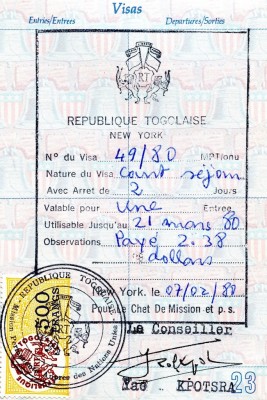 I was sent down the hall to the administration department for a briefing. Several immunizations and a round of malaria pills would be required. But my first task was a trip to the US Passport bureau in Manhattan, along with the flight attendants assigned to the trip, to surrender our passports for insertion of several required visas and to receive temporary documents until the formalities were completed. I was happy to reconnect with two of our crew. Gerry Victor flew regularly into Los Angeles when I was a ticket agent, back in the mid-1960s, and Ann Gerardo was Chicago-based during my DCS tour there, circa 1972–74. Three others I had not met: Bonnie Brooks, Tommie Hurston and Beverly Jorda.
I was sent down the hall to the administration department for a briefing. Several immunizations and a round of malaria pills would be required. But my first task was a trip to the US Passport bureau in Manhattan, along with the flight attendants assigned to the trip, to surrender our passports for insertion of several required visas and to receive temporary documents until the formalities were completed. I was happy to reconnect with two of our crew. Gerry Victor flew regularly into Los Angeles when I was a ticket agent, back in the mid-1960s, and Ann Gerardo was Chicago-based during my DCS tour there, circa 1972–74. Three others I had not met: Bonnie Brooks, Tommie Hurston and Beverly Jorda.
Our purser was to be Joe Bouadana, Boston-based at the time. We had not met but he was well known, as a big, boisterous man with a great sense of humor. Fluent in four or five languages, Joe proved to be an invaluable team member during this adventure.
I took my regular trips for a few weeks, then flew to Kansas City January 29 to meet the charter flight captain, Norman Schaeffer, who seemed overbearing at first, but when I called him Captain, he quickly corrected me, “It’s Norm.” From that point forward we got along just fine.
Before leaving Kansas City, I visited with some engineering folks at the TWA overhaul base to learn about the 707 scheduled to carry us around the globe. N18712 was coming out of regular maintenance, reconfigured with 88 first-class seats and an aft lounge. The large carry-on luggage compartment was to be made secure with locking devices.
707-331B N18712, our home away from home for 35 days. Below: The all first-class cabin and aft lounge.
Back in New York, I had a few meetings with our JFK dining & commissary people to outline the supply needs, then returned to regular flying for another two weeks.
I was formally placed on temporary assignment February 14 and spent long days completing paperwork and lining up needed supplies. On the trip I’d be reprovisioning liquor, wine, champagne, soda, juices, glass and chinaware, bar supplies, plus cleaning items. This load of 3,500 pounds, my private pantry, was to be transported in the forward cargo hold. With so few passengers and no freight to carry, there was plenty of room in the belly. It was much cheaper and more efficient than trying to buy everything en route. At the corporate offices I sat down with Bill Affonso, our charter manager, to review the tour contract, line by line.
The Trip
For 20 years TWA had operated 707 globe-circling charters for various tour companies, over various routings. Some were completed with all-coach charter layouts and a few in 92-seat, all first-class configurations; the same arrangement used on White House press flights and special charters flown on behalf of ARAMCO, the Arabia-American Oil Company. The only difference was a lounge on our airplane, reducing the passenger seating capacity to 88.
Described as a “World Air Cruise,” our tour was organized and managed by Travel Corporation of America, a.k.a. Travcoa, a California-based company specializing in luxury travel. It is still in business.
The per-person cost was $16,000 ($49,600 today). In addition, surcharges were levied up until the departure date, based on rapidly increasing fuel costs. Except for gratuities, everything else was included: airfare, meals, hotels and transfers. Each couple was allowed 300 pounds of luggage, with suitcases designated for warm or cold weather visits. The bags were tagged to allow unloading based on the climate at each stop.
Once through customs, luggage was to be transferred to the hotels and delivered to the guest’s room. Likewise, on departure from a hotel, they had only to leave their suitcases in the room for retrieval and transfer to the airplane cargo compartment.
The manifest listed 81 guests, four tour guides and the Travcoa president, plus a crew of 11.
Claude Rothe was the assigned first officer, with Chuck Frederick as our flight engineer. Claude’s fluency in French, and Chuck’s in Spanish, proved to be valuable assets.

Claude Rothe took this picture during one of our debriefings. Above: Chuck Frederick, Ann Gerardo, Tommie Hurston, Gerry Victor, Bonnie Brooks (at top), Norm Schaeffer, Gino Galli. Bottom: Jon Proctor, Beverly Jorda, Joe Bouadana.
I joined the pilot and flight attendant crew for a pre-departure briefing Tuesday, February 19, at the International Hotel on the airport, where Captain Norm laid down the rules: there would be no rules! He was explicit about the long duty hours and challenges that lay ahead. Although I was technically responsible for the cabin crew, it was quickly apparent that this group was seasoned and professional; my efforts could be directed elsewhere
Earlier in the day Captain Norm and I signed for $25,000 at the airport bank, to pay expenses at locations where credit was not available. All of our stopovers were to be at non-TWA locations. Henceforth, the cash became know as “our maps,” and was carefully guarded.
I passed up the option of staying at the hotel with the rest of the crew, instead rushing home to Connecticut for last-minute items and one more night in my own bed. I was back at JFK by noon Wednesday.
Our Itinerary
Feb 20 – New York – Marrakesh, Morocco
Feb 22 – Marrakesh – Lomé, Togo
Feb 24 – Lomé – Kigali, Rwanda
Feb 28 – Kigali – Mahé, Seychelles
Mar 1 – Mahé – Colombo, Sri Lanka
Mar 4 – Colombo – Shanghai, China
Mar 6 – Shanghai – Beijing
Mar 8 – Beijing – Shanghai
Mar 9 – Shanghai – Bali, Indonesia
Mar 12 – Bali – Port Moresby, Papua New Guinea
Mar 15 – Port Moresby – Rarotonga, Cook Islands
Mar 15 – Rarotonga – Easter Island
Mar 19 – Easter Island – Rio Gallegos, Argentina
Mar 22 – Rio Gallegos – Buenos Aires, Argentina
Mar 25 – Buenos Aires – Miami
Wednesday, February 20
Our flight originated at Kansas City, where about 40 passengers boarded. A domestic crew operated the segment to JFK. Upon its arrival, I stood on the Jetway as the flight attendants got off, exclaiming their envy over our journey about to begin. It was there that I met Gino Galli, a Rome-based maintenance supervisor, who had been assigned to the crew, and began at Kansas City. He and I were to essentially be the ground-support team for this voyage.
Gino quickly huddled with a JFK maintenance foreman. The No. 2 engine turbocompressor had failed en route from Kansas City. TWA’s 707s were equipped with three turbocompressors and could be safely dispatched with only two, so rather than delay the flight at New York, it was decided to put a replacement unit in the cargo hold and change it out at the first opportunity.
Otherwise, all was in order and we could have left on time were it not for two passengers connecting off a delayed flight. During the wait, the tour company president introduced his assistants. Our 81 passengers were divided into four groups, with each assigned a tour director. This and the tour owner brought the revenue payload to 86. Gino and I were assigned the final two regular seats on the airplane, in the last row and across from the lounge. There were two aisle fold-down seats for the fifth and sixth cabin crewmembers. All the seats, except for two in the cockpit and four in the lounge, were spoken for.
With everything in a high state of readiness, Flight 8510 lifted off from JFK for an overnight, 8-hour, 10-minute journey to our first stop. T-minus 35 days and counting.
Thursday, February 21
After a sumptuous rack of lamb dinner and inflight movie, a light breakfast snack was served as our 707 passed high over Gibraltar, followed by a gradual descent for landing at Marrakesh, Morocco, Joe Bouadana’s birth country.
We only had one day here so decided to change out the turbocompressor at the next stop. I oversaw the airplane cleaning and visited the caterer to arrange provisioning for the next day. Unfortunately I missed Joe’s personally guided crew tour of the city, but still managed a quick shower and change of clothes in time for dinner and a floor show at our overnight accommodations in the Es Saadi Hotel.
Left: Our airplane, behind a Royal Air Maroc 727. Right: Dinner at the Es Saadi Hotel.
Friday, February 22
Following a (very) good night’s sleep we departed at mid-morning for Lomé, Togo, in West Africa. Officially known as the Togolese Republic, it is among the smallest countries on the continent.
Left: Part of the crew luggage at the hotel. Right: Boarding at Marrakesh. I’m in the coveralls.
There were numerous overfly restrictions along the route, resulting in a nearly 5-hour flight. First Officer Claude’s French helped smooth out multilingual communications along the way.
An extra day at Lomé allowed time to change out the No. 2 engine turbocompressor, an especially tedious job in sweltering heat. Gino got some help from maintenance personnel of Air Afrique, the ground-handling agent.
Left: Chuck Frederick lends a hand with cleaning. Right: Changing a turbocomprssor in the mid-day heat.
At this point, I decided to handle aircraft cabin cleaning myself, owing to an unfortunate experience at Marrakesh, where numerous items went missing. From then on we would only allow airport personnel aboard when accompanied by either Gino or myself. At Lomé, F/E Chuck pitched in with tidying up in the passenger cabin. Without ground power, it was like working in an oven.
At Lomé I noticed a burned-out, former TWA Constellation in the grass, still in basic company colors. Sold in 1967, it landed here 9 years later with mechanical problems, subsequently caught fire a year later under suspicious circumstances and was abandoned. After taking a few pictures, I was admonished by a guard stationed near the hulk. He is visible in the image below, standing at the right. Had I seen him I definitely would not have taken those shots!
Left: Ground handlers escape the sun around the Caravelle wing. Right: The former TWA Connie.
Back at JFK, I had managed to borrow two pieces of support equipment for the trip, an 8-foot wooden ladder to gain cargo compartment access and an old vacuum cleaner that, it turns out, presented a challenge: it could not be plugged into the aircraft power outlets. Gino worked his magic, splicing the cord into a microfiche machine (containing maintenance manuals) that did fit, but every time I needed to vacuum, we had to haul the microfiche machine up from cargo. However, several pesky aircraft problems required its use anyway.
Sunday, February 24
From the hot and humid weather in Togo, we headed across the African continent on a 4-hour, 2,300-mile flight to Kigali for three-day stay. Located in the center of Rwanda, this capital city sits at an elevation of 5,100 feet.
An earlier than planned departure from Togo resulted in an unannounced arrival time at Kigali, where the Teletype service had been broken for nearly a week. However, a lone truck from the local hotel was there to meet us. When I asked the driver how he knew of our earlier arrival time, he replied, in broken English, that it being Sunday, he was working in the yard at his nearby home. “When I saw the red and white plane fly over, I came right out!”
Left: The Meridien, our layover hotel. Right: Guarding “our maps,” in bags by the table.
Servicing the lavatories became a challenge. With none of the appropriate equipment available, our ground handlers simply opened the dump chutes, letting the contents fall to the ground. Men from the airport fire department provided two 50-gallon drums of water and we formed a bucket brigade to refill the tanks. Fortunately there was enough potable water on board to bypass replenishment at this stop. Meanwhile, two ground handlers helped me with the task of moving items upstairs from the “belly deli.” One specialized in opening Perrier bottles – with his teeth!
Le Meridien, the host hotel, also handled our catering needs and I set up the menu the next afternoon. The only beef entrée available was Zebra steak, a tasty but tough selection. As I recall we didn’t tell the passengers what they were eating until later.
After spending the next day at the hotel pool, Gino and I joined the rest of our crew on a full-day safari in the Gabiro National Wildlife Park. The Rwandan president’s aircraft pilots, who ran an ad hoc tour operation, offered their services. It was nice having Gino was along when one of the van’s fuel pumps failed and he jury-rigged a direct feed from a spare gas can to the engine so we could proceed.
With one day left, the crew planned a 3-hour driving trip to the Volcanoes National Park in the Virunga Mountains to sightsee and view the mountain gorillas. Such visits required permission by radio from a caretaker in the park. On departure morning, she told us the animals were not in a mood to associate with strangers that day, so we reluctantly canceled the plan and returned to the pool.
Thursday, February 28
Above left: our Perrier opener specialist. Above right: Despite a ground support cast of thousands, Captain Norm had Gino handle the engine start and flag-out before climbing aboard through the Lower 41 hatch. Below: On a steep downwind approach for landing at Mahé.
From the moderate temperatures in Rwanda, Flight 8510 headed to more tropical weather. Our 1,700-mile, 4-hour flight plan took us over Tanzania with a view of 19,341-foot Mount Kilimanjaro, and then the Indian Ocean, to Mahé, largest island of the Seychelles.
We arrived in mid-afternoon with another technical problem: the HF (high-frequency) radio was intermittently malfunctioning. Gino began a six-step process to locate the source of this malfunction. Meanwhile I tidied the cabin, restocked items and met with the airport caterer.
The two of us headed to the Mahé Beach hotel that evening, caught a light supper and retired for the night. We learned that this five-star oceanfront resort was fully booked and our crew was about to be doubled and tripled up in rooms when Captain Norm produced a rather large piece of U.S. currency at the front desk, immediately solving the dilemma. Beautiful suites awaited us. If only there had been more time to do anything other than sleep in them.
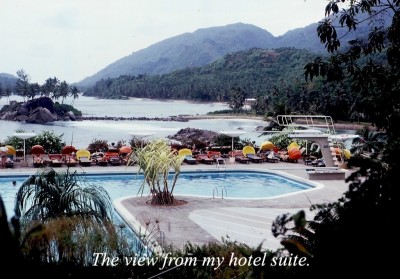 Leap Year Day, February 29, came early and both of us returned to the airport. Gino continued to toil with the radio antenna problem, high on a cherry-picker, a rather harrowing task. Meanwhile, I revisited to the caterer to finalize and approve meal provisioning for our onward flight. This and other tasks kept us busy most of the day.
Leap Year Day, February 29, came early and both of us returned to the airport. Gino continued to toil with the radio antenna problem, high on a cherry-picker, a rather harrowing task. Meanwhile, I revisited to the caterer to finalize and approve meal provisioning for our onward flight. This and other tasks kept us busy most of the day.
We didn’t get back to the hotel until late afternoon. But Joe Bouadana had already arranged a crew dinner on a small island just a few hundred feet from shore, where he and Bonnie Brooks had their own cottage rooms. Gino and I joined the others for a short boat ride to the site, an outdoor dining room and grill. Hotel staff prepared a lobster feast and a good time was had by all.
Lobster dinner in an open-air dining room on a private island, living the good life.
Saturday, March 1
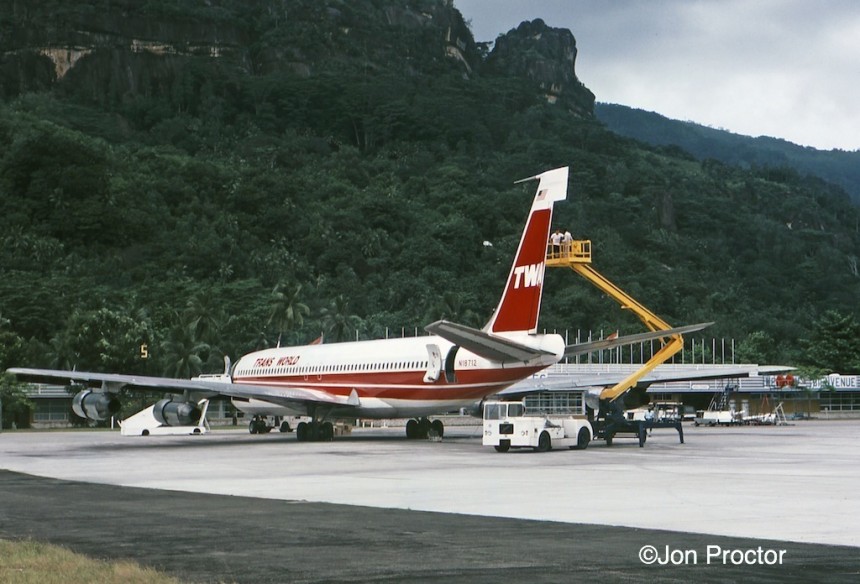
Gino and a helper move the cherry-picker high on the tail to install a replacement radio antenna. Will it work?
This was one stopover that could have lasted a week and not bothered anyone. Leaving Mahé without time to explore all it has to offer was a disappointment, but of course we had no choice.
Flight 8510 departed in mid-afternoon but Gino and I reported early, as usual, to supervise preparations for our onward segment. The replacement radio part arrived that morning and was installed. Prior to takeoff cool tropical drinks in coconut shells were served to our guests, along with cold scented towels.
On this segment, one of my favorite passengers presented me with a sheriff’s badge. Both Chicago natives, Cecilia Christensen and I hit it off from the start. She had recently broken her ankle but didn’t let it slow her down on the trip.
I should interject here that the cabin crew alternated positions during the long trip. Three worked the front half of the cabin and three served from the back, then swapped on alternate segments. Passenger name charts were posted in both galleys, but Joe and his cabin team had them memorized early on.
The next destination, Colombo, Sri Lanka, about 1,800 miles distant, took another 4 hours of flying time, allowing for an evening arrival at Colombo International Airport. While the passengers proceeded to the Intercontinental Hotel, our crew was billeted at an old British hotel, which I learned was used by Lord Mountbatten during World War II.
During part of my dad’s tour with the Air Transport Command, he had been a member of Mountbatten’s staff and attended his staff meetings at Colombo, when the country was still called Ceylon. There was no way to be sure, however I couldn’t help but wonder if Dad might have stayed at this same hotel 35 years earlier.
Left: Twilight arrival at the Colombo Airport. Right: A view of the water from our hotel.
On landing at Colombo, the 707’s No. 1 engine reverser refused to reset, necessitating its replacement. We had two full days here so there was time to address the issue. Air Lanka loaned us the part. It involved removal and reinstallation of 200 support bolts.
Left: Changing the No. 1 engine thrust reverser. Right: Gino precariously standing on a ladder.
Meanwhile, the HF radio antenna replacement part did not solve the problem. Gino had to go back up to pull a different component from the tail compartment. The maintenance steps didn’t quite reach, so our 8-foot ladder was pressed into service.
It was hot and humid in Colombo, adding to the challenge, and ground power was expensive, so I cleaned the cabin in even warmer temperatures. Both of us were happy to leave Sri Lanka.
Tuesday, March 4
Another mid-day departure allowed everyone to get plenty of sleep. The next leg was 2,278 miles, nearly a transcon flight, to begin a fascinating 6-day stay in the People’s Republic of China.
The original plan was to fly to Peking (later called Beijing), but before leaving New York permission to fly intra-China segments was refused, so instead we proceeded to Shanghai, arriving after sunset, with the passengers scheduled to ride Chinese flag carrier CAAC to Peking and back.
Ours was the first US airliner allowed to land in China since 1972, when Pan Am and TWA 707s brought the press there during President Nixon’s historic visit. We were greeted by an attractive Chinese woman, probably in her 20s, who came aboard and welcomed everyone in perfect English.
Another sight for sore eyes on arrival was Desmond Yee, TWA’s district sales manager for the Central Pacific, who was to break down language barriers for us. As I recall, his fluency in Mandarin did not completely meet the challenge of local dialects but it certainly helped. Desmond also replenished our cash supply.
This was the first stop where we unloaded our passengers’ cold-weather luggage, in anticipation of chilly temperatures in China. Indeed it was near-freezing or below for our entire stay. Passengers and crew were accommodated at the Ching Chiang Hotel, where President Nixon had stayed during his visit.
 While passengers and the rest of the crew toured Shanghai on Wednesday, Gino and I were back with the airplane. I cleaned and re-provisioned then helped with a 50-hour maintenance inspection.
While passengers and the rest of the crew toured Shanghai on Wednesday, Gino and I were back with the airplane. I cleaned and re-provisioned then helped with a 50-hour maintenance inspection.
Gino also managed to fix the HF radio that had plagued us for so long. It turned out that the first part replaced was the culprit causing all our problems, but the replacement itself was defective. Now a third one solved the problem. I recall Gino shaking his head in disbelief.
That afternoon Desmond Yee and I arranged for onward catering with a local restaurant. Having not seen an airline meal tray or any other galley components, this must have been a challenge but Desmond told me they were competent and I shouldn’t worry. Easy for him so say … .
Thursday, March 6
The tour company arranged hotel rooms for both passengers and crew so we all had to remain together in China. As a result, everyone departed for Peking on a chartered CAAC Trident 2. Its accommodations were quite a contrast from our roomy 707. Tight seating was the norm but no one seemed to mind on a 1-hour, 30-minute flight. Especially amusing to our pilots was the 5-man cockpit crew, including a navigator and radio operator.
That evening everyone was treated to a traditional, multi-course Peking duck dinner in a large banquet hall, with multiple toasts from local officials. I was struck by the fact that this Chinese feast looked and tasted just like a meal in an American restaurant serving the same fare. Everyone went to bed stuffed that night, in a hotel that could have easily passed for World War II barracks, albeit with single accommodations. There were no locks on room doors, thus no keys. A notice on the wall, in both Chinese and English, listed an extra charge for heat. Apparently it had been paid for, as the room was comfortably warm.
Left: Friday lunch with our guide. Right: Everyone got a Great Wall certificate.
The next day, with no airplane to take care of, Gino and I enjoyed touring with the rest of our crew and passengers. We visited typical Chinese residences, a school and farm and, of course, the 2,500-year-old Great Wall of China. Our TWA parkas came in handy in the cold, cloudy weather.
Saturday, March 8
Left: Taking photos at a local school. Right: Children are especially precious in China.
After a visit to the Palace Museum, Tiananmen Square and The Forbidden City, we boarded another CAAC Trident for a late-afternoon flight back to Shanghai. On that segment I pinned TWA junior flight attendant wings on one of the CAAC crew and watched her eyes light up. She wore them for the entire flight and, through an interpreter, asked for more wings to give to the other attendants.
Left: In Tiananmen Square. Right: Locals marvel at Polaroid technology.
Arriving at the hotel by dinnertime, we were thoroughly worn out from the previous day’s tours and bus rides. Everyone ate early and settled in for the night.
Left: The CAAC Trident that took us back to Shanghai. Right: TWA junior wings on a pretty flight attendant.
Sunday, March 9
Despite the warm hospitality from our Chinese hosts, I think we all were looking forward to the warm weather our next destination promised, 2,777 miles to the south.
I don’t recall why, but it took us just over 6 hours to reach Denpasar International Airport at Bali, Indonesia, soon after sunset. As was his practice, Captain Norm flew over the airport for a look-see, and then turned back for a long approach to the runway. After landing came an announcement: “Gino to the cockpit!” This was not a good sign. It seems the No. 3 engine oil pressure dropped to near zero as we rolled out on the runway.
After overseeing unloading of the warm-weather luggage and galley equipment, I returned to the cockpit, where Gino was about to ask the tower for permission to run the engine up to idle power. Whatever the results were, Gino didn’t like them. A scheduled three-night stay here allowed some leeway and we decided to button up the airplane and address the issue in the morning.
But the situation did not improve the following day. Gino was on the phone with our Paris dispatching center most of the morning and it was agreed: an engine change was required. A plan was developed to ship a spare powerplant on Thai Airways, from Paris via Jakarta, for arrival the following day.
Meanwhile, with the help of Garuda Airways mechanics, Gino began removing components from the bad engine, again in hot, humid weather. Off came the turbocompressor and thrust reverser (200 more bolts).
When not serving as Gino’s “go-fer” I took the opportunity to consolidate the remaining contents of my belly deli. Our rooms at the beautiful Intercontinental Hotel Bali Beach didn’t get much occupancy time.
The replacement JT3-D engine finally arrived on Tuesday, March 11, as did six Singapore Airlines mechanics, to assist Gino (Garuda lacked 707-qualified mechanics). However, everything ground to a halt when Indonesian officers refused access to the powerplant until Customs clearance “formalities” were completed. When asked how long this was going to take, the response was, “Maybe tomorrow but probably longer.” The flight was scheduled to leave Wednesday night and Gino had already scoured the area to secure a crane capable of lifting 6,000 pounds for the change-out. He wound up securing it from the Indonesian military, complete with a crane operator.
A.X. Almeida, Jr., TWA’s district sales manager for Southwest Asia, had flown in to assist us and appealed to the Customs people, pointing out that the engine wasn’t being taken off the airport and should not even be subject to Customs interference. He was told, however, that payment of “appropriate charges” was required and the amount was yet to be determined. Until then, we could not touch the quarantined shipment. I nearly had to physically restrain Gino.
The tour contract stated that TWA was not responsible for delays caused by mechanical issues. But back in New York Bill Affonso started looking into alternate transportation to the next stop, Port Moresby, Papua New Guinea, in order to keep the tour on schedule. As he later told me, it was done “because we’re a good airline.”
Port Moresby is the home base for Air Niugini, so it made sense to charter an airplane from that carrier. As luck would have it, another 707 was available for the task.
Meanwhile, negotiations continued for release of our precious engine, which was finally granted upon payment of Customs fees plus a little extra to accelerate the transaction.
It was decided I should load our galley equipment on the charter airplane and leave with our passengers in order to get a head start with planning for the following segment. Reluctantly I left the rest of our crew and headed out on the Air Niugini Bird of Paradise 707, bound for New Guinea.
Wednesday, March 12
At Bali we had unloaded both warm and cold weather luggage so the passengers could re-arrange their belongings, then put the cold weather satchels back on N18712 a day later. Now it was time to depart and one couple had accidentally packed their passports in the wrong luggage. With Air Niugini ready to whisk us off, the male passenger and I began digging through our own cargo hold. Just by luck the suitcase was close to the entry hatch and the documents were quickly retrieved.
On taxi out for takeoff, Gino and his helpers could be seen slaving away with the engine replacement project at an adjacent gate.
Our 2,190-mile flight arrived at Port Moresby soon after daybreak the next morning, where connecting flights took the passengers on to the outer island points of Mount Hagen and Goroka for sightseeing.
I was met by a bevy of Air Niugini ground staff, including the head of catering, who helped supervise transfer of TWA galley equipment to the airline’s flight catering facility and sat down with me to plan the menu for our onward journey. These people were so friendly and efficient I let them clean the aircraft cabin unsupervised and they did a terrific job, spending extra time to scrub down the lavatories and galley surfaces.
There were some tense moments at the hotel that afternoon. The coalition government, led by Chief Minister Michael Somare, had been overthrown a day earlier. Some frightened members of his party took refuge in the hotel and space was in short supply. Eventually it was all sorted out but not before I spent time in the lobby awaiting my room. I had dinner there, joined by some of my newfound Air Niugini friends, and retired early.
A day later N18712, complete with its replacement engine, arrived from Bali, pulling into the gate just as our passengers were returning from their excursion. A loud cheer arose as Captain Norm opened the cockpit window and gave a thumbs-up signal. Gino Galli came bounding down the stairs with the aircraft logbook, wearing a big smile. “Look, Jonny,” he exclaimed, “No open items!” The HF radio was functioning, our earlier-replaced thrust reverser was working fine and the No. 3 engine had performed flawlessly en route from Indonesia.
The two of us joined fellow crewmembers for a celebration dinner that evening, then enjoyed a full day off, realizing we had surpassed the halfway point and were about to begin our homeward push.
Saturday, March 14
Flight 8510 departed late this morning on its longest segment of the trip, 3,724 miles, en route to Rarotonga in the Cook Islands. I was invited to sit in a cockpit jumpseat for a high-performance takeoff. The load sheet said we weighed the maximum 334,000 pounds. Part of the reason was fuel tankering to take advantage of lower prices at Port Moresby. This all-daylight flight was pleasant and relaxing, particularly for Gino. A volcano could be seen erupting on the island nation of New Hebrides, which gained its independence that year and was renamed Vanuatu. This, plus lunch, an inflight movie and pre-arrival snack kept our passenger entertained.
This all-daylight flight was pleasant and relaxing, particularly for Gino. A volcano could be seen erupting on the island nation of New Hebrides, which gained its independence that year and was renamed Vanuatu. This, plus lunch, an inflight movie and pre-arrival snack kept our passenger entertained.
Another highlight on this segment was passing the International Date Line. Suddenly, it was March 14 again, even though we departed on the 15th.
If our ground handling at Port Moresby was efficient, it was elevated to superb at Rarotonga, where Flight 8510 landed in the early evening.
Air New Zealand took care of all our needs with the utmost efficiency. In addition, Dick Llewellyn, TWA’s district sales manager for the South Pacific, met the flight and provided support, including a final uplift of cash.
Back at Port Moresby, someone placed a baggage sticker on the No. 3 engine nacelle, which said, simply, “BALI.” Now a sign painter was secretly commissioned to inscribe, beneath the sticker, the possessive “Gino’s.” Actually, we could have made the painter rich by appointing him to hallmark every item Gino’s genius had touched. Not only the aircraft repairs but also two cameras belonging to passengers, a flight attendant’s tote bag zipper and several other items.
The Rarotongan Hotel was not large enough to house both passengers and crew so we were billeted in what amounted to dormitory living at a nearby hostel.
Captain Norm held a crew meeting, which he called a “pickle squeeze,” complete with two cases of cold beer and T-Shirts he had sent in. Each read: “No Maddies,” to signify the necessity of everyone getting along. Joe refused to wear his! Everyone sat around, drank beer and aired their grievances. Actually, there were none of great consequence.
The next morning we checked out and were driven to the Rarotongan for the balance of the day, enjoying the adjacent beach and catnapping for the overnight flight ahead.
Saturday, March 15 (again)
It was time to press on with an overnight flight across the South Pacific to Easter Island. Owing to Rarotonga’s relatively short runway, a fuel stop was required at Pape’ete, Tahiti, 670 miles to the east-northeast. From there it was another maximum-weight takeoff for the 2,560-mile segment, tankering as much fuel as possible and creating capacity to fly the additional 2,300 miles to Santiago, Chile if necessary.

En route to Easter Island and adorned with Tahitian flowers, Bonnie horses around in the lounge; Tommie looks on.
Isla de Pascua (Easter Island in Spanish), known as Rapa Nui in the Polynesian tongue, is a Chilean territory located in the southeastern Pacific Ocean, nearly mid-way between Tahiti and Chile. Described as one of the most isolated populated islands in the world, famous for its mysterious statues, known as moai.
At the time of our visit, the runway and adjacent parking area were the only paved surfaces on the island. LAN Chile provided weekly Santiago-Easter Island-Pape’ete service in each direction.
A major portion of the island’s 3,000 population turned out to meet our flight, the first non-Chilean airliner to ever land there. After passenger deplaning for this three-night stay, the airplane was moved to a remote parking spot across the runway, making way for the scheduled LAN-Chile flight, due in the following day.
Left: On final for landing. Right: Our welcoming committee. VW vans rule on Easter Island
A pickup truck was used to move our galley equipment to a small building for cleaning and replenishment. We then retired to the Hanga Roa Hotel to catch up on sleep. The establishment was rudimentary at best, something less than the most basic motel you can imagine. These were also the only guest sleeping accommodations on Rapa Nui. But everyone was tired and went horizontal to get some rest following the all-night journey.
Left: I took this picture of our crew on arrival. Right: Transportation by Suzuki.
A day later Gino and I took care of the airplane, cleaning and inspecting, then buttoning it up. We rented motorbikes to get back and forth from the hotel. LAN-Chile dumped the lavs and provided ground power for exactly 30 minutes. Bottled gas provided the island’s electrical needs, at a steep price.
Left: Mysterious statues stare out to sea. Right: A giant moai, still in the ground, unfinished.
March 17, St Patrick’s Day, was spent touring the island, followed by a cocktail party hosted by our passengers in the crew’s honor. It was the first time I could recall when a TWA customer bought me a drink, a reflection of our guests’ character and generosity.
Left: Bonnie with passenger Leona Hughes, our most-senior guest. Right: Jon and Gino, pals forever.
Here’s an interesting side note. A novel, Shuttle Down, by Lee Correy, was published several months after our visit, describing a fictitious emergency landing by the US Space Shuttle on Easter Island. Shortly after the book’s publication, our government paid the Chilean authorities to improve the runway for just such an emergency, even to the point of widening the strip to accommodate NASA’s specially modified 747 so the Shuttle could be flown out. Such a diversion would certainly have been an emergency. As we know, it never happened, and Rapa Nui got a nice airport improvement with our government’s compliments.
Saturday, March 22
 We left in the morning, on another trans-con equivalent, the 2,692-mile segment to Rio Gallegos, Argentina, nearly all of it over water. Only a small amount of additional fuel was added, thanks to the quantity we had tankered in. It was going for more than $3 per gallon here, an outrageous amount back then but necessary based on the cost of transporting it from Chile by ship. This was the most paid for the precious commodity, although Kigali was a close second. And, along with ground and catering charges, it was on a cash-only basis, nearly draining what was left of our stash, but this was the last time we had to pony up dead presidents.
We left in the morning, on another trans-con equivalent, the 2,692-mile segment to Rio Gallegos, Argentina, nearly all of it over water. Only a small amount of additional fuel was added, thanks to the quantity we had tankered in. It was going for more than $3 per gallon here, an outrageous amount back then but necessary based on the cost of transporting it from Chile by ship. This was the most paid for the precious commodity, although Kigali was a close second. And, along with ground and catering charges, it was on a cash-only basis, nearly draining what was left of our stash, but this was the last time we had to pony up dead presidents.
Turning onto the runway, I noticed a single, antique-looking, fire engine at the ready; the extent of emergency support; may the force be with us! Engine power was reduced almost immediately after liftoff and the airplane banked sharply to the left, giving Gino and me pause; we looked at each other in wonderment. Another problem? No, it was just Captain Norm giving passengers a little scenic tour of the island, on our way out of town, so to speak. After circling to the left, he turned back to the right so our side could catch a final glimpse, then applied climb power and it was off to South America.
Some will recall that Rio Gallegos is where the 1982 Falklands War air power was launched from. Serving as both a military base and commercial airport located in the Patagonian province of Santa Cruz, Argentina, it was a quiet facility when we visited. Carlos Asensio, TWA’s representative for Argentina, met the flight and had already completed most of the ground arrangements, even setting up our catering.
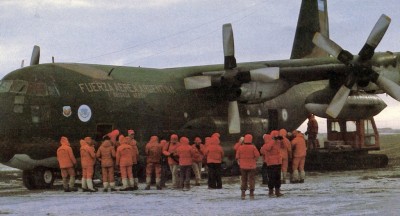 During the three-night stay, passengers were taken on a day-trip excursion to Tierra del Fuego, the world’s southernmost city. Then came one of the tour highlights: a visit to Antarctica. Many of our guests booked this trip just to reach the bottom of the Globe.
During the three-night stay, passengers were taken on a day-trip excursion to Tierra del Fuego, the world’s southernmost city. Then came one of the tour highlights: a visit to Antarctica. Many of our guests booked this trip just to reach the bottom of the Globe.
A disclaimer advised that prolonged stormy weather could prevent the visit, but luck was with them. Two flights on an Argentine Air Force C-130 Hercules transported the group to the Marambio scientific research base, for a warm welcome in the antarctic cold, lunch and a facility tour. This was reportedly the first civilian group given the privilege of visiting Marambio.
 There were a few extra seats on these flights and the crew drew numbers. Naturally Captain Norm was exempt and got to go. But others, including me, did not win the lottery.
There were a few extra seats on these flights and the crew drew numbers. Naturally Captain Norm was exempt and got to go. But others, including me, did not win the lottery.
 Gino and I spent our first layover morning with the airplane, then joined Joe Boudana for lunch to sample 30-ounce steaks, called “baby beef” by the proprietor. They say when in Rome, do as the Romans do. In Argentina, it’s steak, pure and simple. I don’t know how they did it, but ours were grilled to perfection: crusty on the outside and hot pink on the inside. Warm bread and a salad accompanied the entree, which we washed down with Argentine Saint Felecien Cabernet Sauvignon. I believe it took nearly two hours to consume this outrageous meal. Needless to say, a nap followed.
Gino and I spent our first layover morning with the airplane, then joined Joe Boudana for lunch to sample 30-ounce steaks, called “baby beef” by the proprietor. They say when in Rome, do as the Romans do. In Argentina, it’s steak, pure and simple. I don’t know how they did it, but ours were grilled to perfection: crusty on the outside and hot pink on the inside. Warm bread and a salad accompanied the entree, which we washed down with Argentine Saint Felecien Cabernet Sauvignon. I believe it took nearly two hours to consume this outrageous meal. Needless to say, a nap followed.
Left: The Moreno Glacier from afar Right: Up Close; that’s Gino on the cliff’s edge.
The following morning Joe, Ann Gerardo, Gino and I went to see the majestic Moreno Glacier, 200 miles north. The ride, in a 4-wheel drive vehicle, took 5-1/2 hours each way, most of it over unpaved roads. Two flat tires slowed us down, but seeing the Glacier more than made up for what it took to get there. Occasionally giant pieces fell from its face into the water, sending splashes high in the air. Check out this video showing the glacier.
https://www.youtube.com/watch?v=d-wkhp4mSm8
Saturday, March 22
 Today’s 3-hour flight was entirely over land, a 1,294-mile segment north to Buenos Aires. It afforded a late-morning departure with lunch served en route. All was well until we approached the Argentine capital just as a cold front came roaring through after five days of record heat.
Today’s 3-hour flight was entirely over land, a 1,294-mile segment north to Buenos Aires. It afforded a late-morning departure with lunch served en route. All was well until we approached the Argentine capital just as a cold front came roaring through after five days of record heat.
Letting down for our approach, Chuck Frederick suddenly blurted on the P/A system, “Everybody SIT DOWN!” Gino was in the cockpit and I was seated, when Joe Bouadana slid into Gino’s spot next to me and buckled up. From our location in the last row, we watched the 707 starboard wing flapping, its engines bouncing wildly. Behind us food container doors sprung open, depositing dish and glassware all over the galley and adjacent floor with a crash.
 The turbulence exceeded anything I had ever experienced, and it continued until near touchdown. Suddenly, Captain Norm put the airplane into a climb, executing a missed approach. I thought, Oh no, not back up into that angry sky! But around we went, in a tight turn. The tower people cleared us for an immediate landing and it only took a few more minutes to reach terra firma. Passengers and cabin crew alike let out a cheer.
The turbulence exceeded anything I had ever experienced, and it continued until near touchdown. Suddenly, Captain Norm put the airplane into a climb, executing a missed approach. I thought, Oh no, not back up into that angry sky! But around we went, in a tight turn. The tower people cleared us for an immediate landing and it only took a few more minutes to reach terra firma. Passengers and cabin crew alike let out a cheer.
Pulling up to our remote parking stand, the airplane continued to shake from the wind and heavy rain. We had to wait nearly 30 minutes until the ground staff could position steps and help us off the airplane. One passenger stated, quite seriously, that he saw a tornado funnel and we had flown through it!
Captain Norm later explained that a wall of rain had quickly obliterated visibility about halfway down the runway, forcing him to abandon the approach. “I didn’t want to stay up in the air any more than you guys, but had no choice,” he added.
Carlos Asensio arranged a bus tour for us the next day, to see this beautiful city and enjoy lunch at a local eatery. Travcoa hosted a farewell banquet party for passengers and crew, celebrating the company’s 25th anniversary, but my friend, Pan Am Purser Barbara Norberg, managed a Buenos Aires layover, so she and I ate at La Mosca Blanca (“White Fly” in Spanish), one of her favorite restaurants, then joined everyone at the party, for dessert and dancing.
Monday, March 24
 Most of us rested up during the day for our overnight flight to Miami. While at dinner the night before, Barbara mentioned that the longest Buenos Aires Airport runway had just been closed for construction, so they were going to make a fuel stop on the Pan Am flight back to New York. I relayed this information to Captain Norm.
Most of us rested up during the day for our overnight flight to Miami. While at dinner the night before, Barbara mentioned that the longest Buenos Aires Airport runway had just been closed for construction, so they were going to make a fuel stop on the Pan Am flight back to New York. I relayed this information to Captain Norm.
A quick call to TWA’s JFK dispatch office confirmed a “pit stop” was going to be required; we couldn’t fly the 4,500-mile segment nonstop without using the longer runway. It was decided to pause at Curacao, and the departure time was moved up an hour so as to arrive at Miami in time for connecting flights.
A light rain fell as we greeted our guests for the homeward trip. No movie this time, and everyone but the crew fell asleep, some before takeoff. A light snack was offered but not everyone accepted. It took us 7 hours to reach Curacao, landing just before dawn. American Airlines took care of the refueling and Flight 8510 headed north again, just 1,195 miles and 2 hours, 35 minutes from America.
The sight of TWA ground equipment and personnel were most welcomed as we pulled into the gate at Miami International Airport, our U.S. re-entry port. A domestic crew was waiting to take over for the final leg back to Kansas City.
Left: Refueling at Curacao. Right: Sunrise over the Caribbean.
Ninety-seven travel-weary souls filed off N18712, and into Customs to declare their many acquisitions from more than 40,000 miles of travel. I closed up my bags and packed away my passport, contemplating that old familiar expression, “It’s a small world.”
There were a lot of good-byes, hugs and exchanges of addresses between passengers and crew. By then we knew them all by first name and it seemed as though a family was breaking up after a month-long reunion. But the memories would be kept for a lifetime by those of us who were fortunate enough to cross the equator four times, span three oceans, and circle the globe on The Great World Air Cruise of 1980. I was a lucky man to be part of it!
Epilogue
A friend and fellow philatelist asked me to bring along this envelope, adorned with stamps from all the countries we were to visit, and have them cancelled by the post offices. In addition, he provided another for me to return after the trip. The request struck me as a great opportunity to get the crew involved, so I made up 10 more envelopes and had all 12 hand-cancelled at the JFK Airport Post Office on departure day. We then purchased required stamps along the way. Although I made many of the post office visits, other crewmembers carried the torch on several occasions, going so far as to entice the postmaster at Rarotonga to open the office on a Sunday just to accommodate our request. The Antarctica cancellation (to the right of the address label) created quite a stir at the Marambio base as it did later in the trip, when locals saw all the countries we had visited.
In March 1982, Ann Gerardo organized a trip reunion, held in Chicago. We invited passengers to join us and several did.
We Remember
Sadly three of us are gone.
With his 1944 seniority date Captain Norman Schaeffer could have been flying the 747 in 1980 but chose to remain with his favorite airplane, the 707. He retired shortly after our charter flight and passed away in 1989.
Joe Bouadana left us on January 23, 2010, at age 70. Click on Bouadana Obit to read a heartwarming tribute to this true TWA legend.
Gino Galli was taken far too early in life, suffering a fatal heart attack in 1988; he was not yet 50. After our trip I nominated him for the company’s Award of Excellence. Here is the Award of Excellence nomination reply from TWA’s head of maintenance, supporting my submission. Gino received the honor and no one deserved it more. He was a wonderful man.
I recently made contact with Gino’s son, Gianantonio, who passed along these pictures.
Gino, on left, with his fellow workers at Rome, on September 29, 1987, in front of the TWA 747 that carried Pope John Paul II back to Rome following a US visit. By then Gino was head of maintenance for Italy.
Left: The Gino we remember. Right: He is buried in the village of San Fermo di Gazoldo near Redondesco, his birthplace. The passage reads: “God is light and there is no darkness in Him – St John”
On a positive note, I still keep in touch with Gerry, Bonnie, Ann, Tommie, Chuck and Claude. All are in good spirits. Hopefully we can all get together at least once more to celebrate our adventure that took place more than 35 years ago.
Copyright © Jon Proctor 2015. All Rights Reserved.






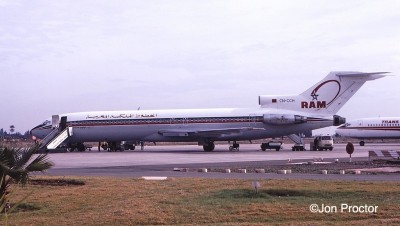






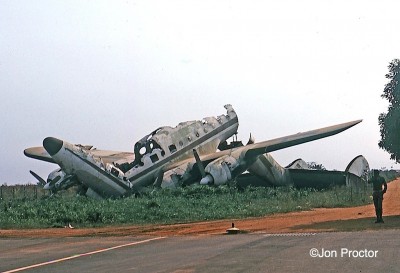
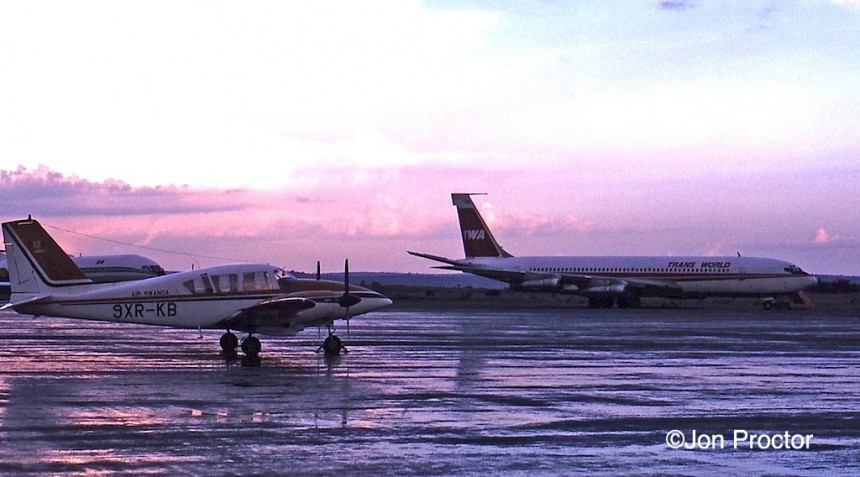



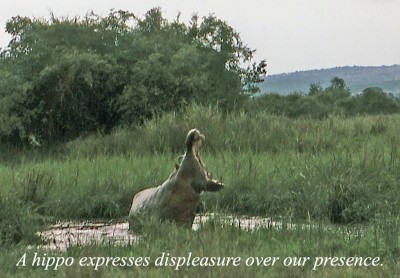








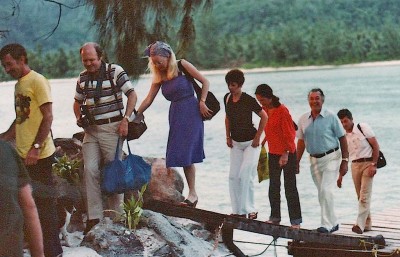






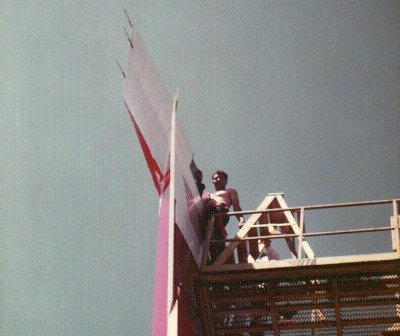




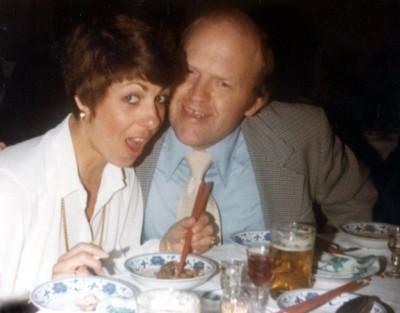


















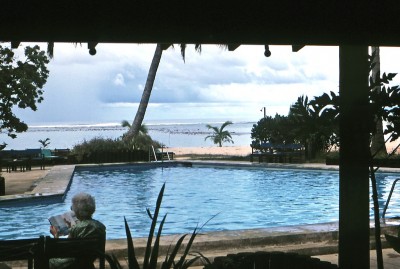

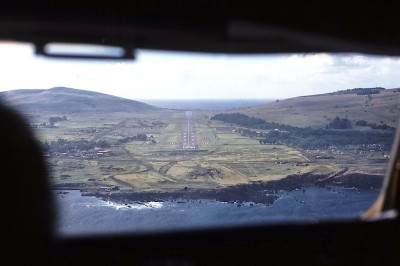











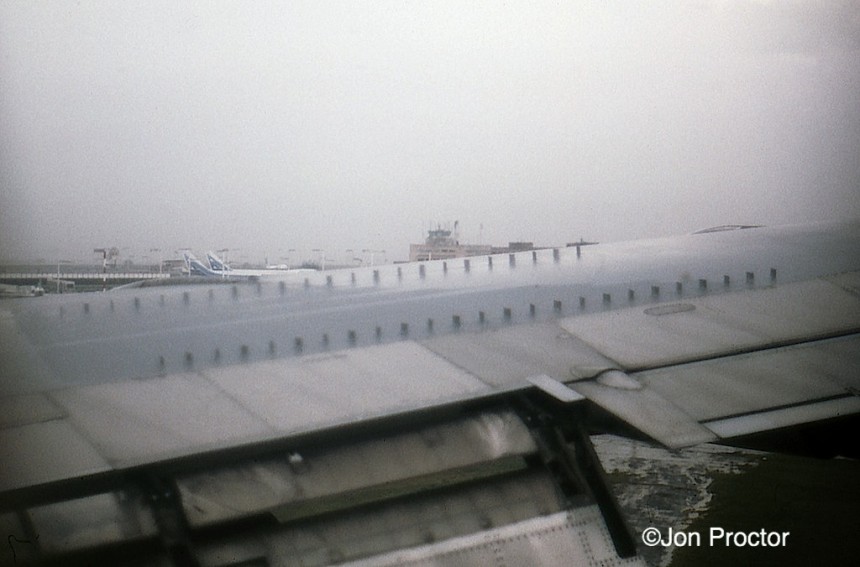



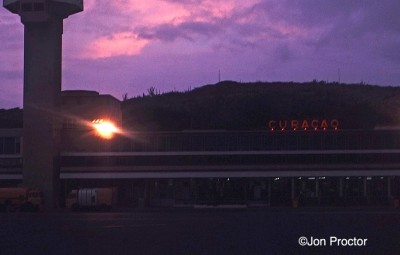

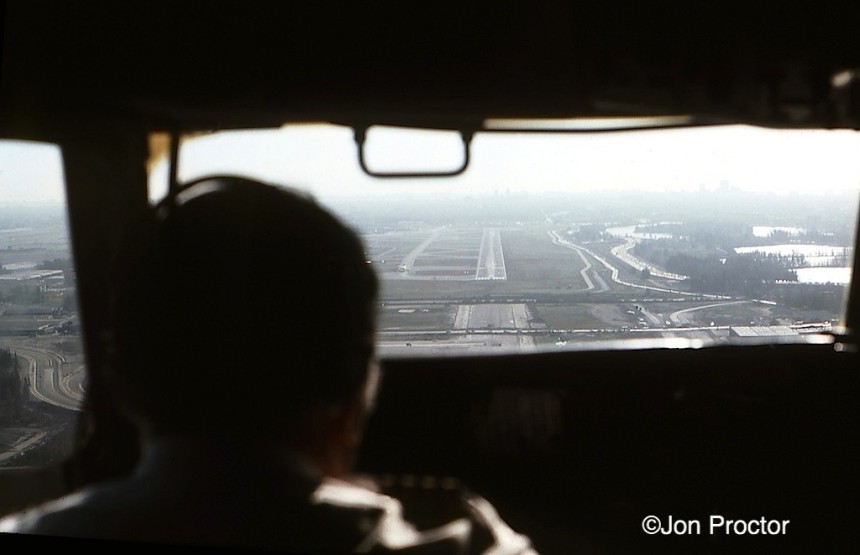




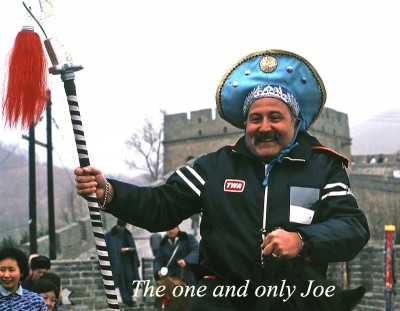



Jon, thank you for sharing this wonderful adventure.
Fantastic
A fantastic Voyage. Very well told too. Thanks.
Great article. I was based in SFO at the time and had flown with Claude Rothe often. What an adventure. John Eddy, TWA 1967-2002.
Ciao Jon, thank you for sharing such a wonderful trip around the world.
What is really impressive to me is all the details you put in this page, after more than 35 years!
I suppose this trip was a dream that came true for you, so… you are a lucky man!
A wonderful and thoroughly enjoyable tale, Jon! Thank you.
As SFO F/E, Claude and I worked together many times, and also knew Ann Girardo from earlier years based at ORD.
Great article, Jon. I love reading your work. As a long-time TWA passenger I devour anything relating to the airline. I especially love reading first-person accounts of their adventures. Can’t wait for the next installment. Thanks!
Thanks Jon for sharing your most interesting trip and pictures from your trip around the world.
Betty Smith
TWA Clipped Wings
Thank you Jon, for the wonderful nostalgic trip around the world which you and our TWA crew flew in 1980. We all lived vicariously through you. Great memories and great people. Thank you. Former F/A JFK. 1966-2001.
Excellent Jon! As usual, another well documented, well written, amazing TWA history.
I’ve had the the honor of flying with some of these people. That must have been a trip of a lifetime Great memories
Hi I am writing because I’m the son of Gino Galli my name is Gianantonio. I saw the photos published. They are a beautiful and emotional reminder from that trip around the world. I do not write very well in English and have used a translator to write. Thank you very much to have published those photos and remembering my father. Greetings Gianantonio Galli
It was an honor to know and work with your father, Gianantonio. I’m so happy you enjoyed the story.
I am in tears! So many familiar faces…especially Joe Bouadana with whom I flew many times…and dear Gino Galli who was such a sweetheart. I miss my 20 years with TWA – what a wonderful time. Thank you, Jon, for putting this amazing history together.
As a former TWAer (1966-1981) this wonderfully documented and written journal brings back so many fond memories of the “good old days” when resourceful TWA employees were able to make commercial aviation a special adventure. Many thanks for allowing others to share vicariously in this amazing experience.
Hi Jon, I thoroughly enjoyed your article. As a former TWA family member (1969-2001) it brought back so many wonderful memories of the
glory years of our wonderful airline that left much too soon. As it happens, my brother lives in Bethel, Ct. and I would love to meet you
if you still live in that area. Please email me at your convenience.
Thanks for the kind words, Noel. I relocated to Sandpoint, Idaho in 1993, but have fond memories of Bethel. Look me up if you get out this way.
Best Regards,
Jon
What a trip! Great job organizing the images & info. Best Steve